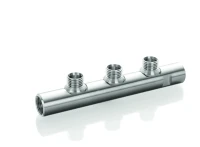- What are electrical connectors and how do they function in hydrogen system?
- What are the key components of an electrical connector?
- How do electrical connectors ensure safe and reliable connections?
- What benefits do electric connectors offer in terms of efficiency and performance in hydrogen systems?
- What types of materials are used in electric connectors to resist corrosion in hydrogen environments?
Browse all electrical connectors from leading suppliers on our marketplace!
What are electrical connectors and how do they function in hydrogen system?
Electrical connectors are components that are used to enable electric connections. Within hydrogen value chains, there are lots of systems, subsystems or components which have modular and scalable structures, e.g., electrolysers, fuel cells, hydrogen storages and refueling. Electrical connectors can be used to establish the safe transmission of power, signal, and data between the modules, the control system, and the BOP (Balance of Plant).
What are the key components of an electrical connector?
Electrical connectors consist of inserts, contacts, hoods, housings, and accessories to fulfil the requirements of an application. Various inserts and contacts can fulfil different requirements for currents and voltages in order to safely transmit power, signal, and data. Different hoods, housings, as well as accessories, provide the necessary protection depending on the application’s environment. The modular design of electrical connectors helps to realize space and time savings, and, therefore, savings in TCO (Total Cost of Ownership) during the life cycle of a hydrogen system.
How do electrical connectors ensure safe and reliable connections?
Electrical connectors fulfill industry standards and specifications like DIN EN 60664-1, DIN EN 61984 to ensure safe and reliable connections. The unique design of termination technologies (crimp, Han-Quick Lock® and Push-in®) ensures stable wire connections. The insulated inserts have a conductive protective earth and are polarized so that they can only be mated correctly. Hoods and housings meet the requirements for protection against electric shock, ingress of water and dust (IP protection class) and the impacts of harsh environmental conditions (salt spray, UV, ozone). They also enable intrinsic safety. This means that the connectors are constructed with features that prevent the occurrence of sparks or excessive heat, minimizing the risk of ignition in potentially explosive atmospheres. This intrinsic safety aspect is crucial in applications where explosive gases or dust are present, providing an additional layer of protection and reliability to the overall electrical system.
What benefits do electric connectors offer in terms of efficiency and performance in hydrogen systems?
- The modular and robust design of electrical connectors enables the stable transmission of power, signals and data for monitoring and control – e.g., of electrolyser stack modules and hydrogen storage, power transmission for the modularized and containerized hydrogen systems (e.g., fuel cell powertrain), ensuring the high efficiency and stable operation of hydrogen systems.
- The plug-and-play capability of the electrical connectors can also help save time and avoid errors in the installation, operation, and maintenance of hydrogen systems. The aim is to improve operating efficiency and reduce TCO (Total Cost of Ownership) throughout the entire life cycle of a hydrogen system.
- The modular nature of electrical connectors allows for adaptability and scalability within hydrogen systems. This feature is particularly advantageous in systems where the configuration may change over time or where components need to be added or replaced. The connectors provide a flexible and efficient means of integrating new modules or expanding the system without requiring extensive reconfiguration, thus supporting the dynamic nature of hydrogen applications.
- Modern electrical connectors are designed to be compatible with smart technologies, enabling advanced monitoring and control capabilities. Integration with sensors and monitoring devices enhances the system’s ability to gather real-time data on performance parameters, contributing to proactive maintenance practices. This connectivity supports the implementation of predictive maintenance strategies, optimizing the reliability and longevity of hydrogen systems.
What types of materials are used in electric connectors to resist corrosion in hydrogen environments?
In hydrogen environments, where corrosion resistance is crucial for the longevity and performance of electric connectors, various materials are chosen based on their ability to withstand the unique challenges posed by hydrogen exposure. Common materials used for corrosion resistance in electric connectors within hydrogen environments include:
Stainless Steel:
Stainless steel is a popular choice for electric connectors due to its inherent corrosion resistance. Alloys such as 300 series (e.g., 304, 316) are known for their resistance to rust and corrosion, making them suitable for applications in hydrogen-rich environments.
Nickel Alloys:
Nickel and nickel-based alloys, such as Inconel, offer excellent resistance to corrosion and high-temperature oxidation. These alloys are often selected for their durability in harsh conditions, including those found in hydrogen systems.
Titanium:
Titanium and titanium alloys are known for their corrosion resistance, lightweight nature, and high strength.
They are suitable for applications where exposure to hydrogen and other aggressive substances is a concern.
Polymer Coatings:
Some connectors incorporate polymer coatings or platings to protect against corrosion. PTFE (Polytetrafluoroethylene) and other high-performance polymers may be used as coatings to create a barrier between the connector material and the hydrogen environment.
Corrosion-Resistant Alloys:
Specific alloys engineered for corrosion resistance, such as those containing molybdenum or chromium, may be employed in connector construction. These alloys are designed to withstand aggressive chemical environments, including hydrogen exposure.
It’s important to note that the selection of materials depends on the specific requirements of the application, the severity of the hydrogen environment, and other factors such as temperature, pressure, and the presence of impurities. Additionally, industry standards and regulations may influence the choice of materials to ensure compliance with safety and performance requirements in hydrogen systems.
Content contributed by HARTING Technology Group
High-performance connection technology forms the basis of industrial application and product technology. The HARTING range of products and solutions comprises connectors,device connection technology and network components. HARTING products connectmachines and facilities via data, signal and power. These offerings enable solutions for thefollowing markets: automation, energy, railway, machinery, robotics, mobility and smartinfrastructure. HARTING employs around 6,200 people across its 44 sales companies and14 production locations.
Last update: 15.02.2024.



